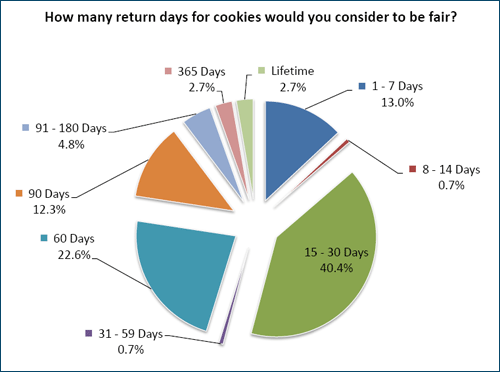Having surveyed over a thousand of affiliates “on their methods, preferences, and strategies”, Affiliate Summit has put together its newest 2010 AffStat Report [source], and made it open to public (free of charge) yesterday, April 20. I’ve been waiting for this one to be announced, and been glad to see it coming out two months earlier that AffStat 2009 did. It is also great to see that unlike the 2009 survey (which had some 450 affiliate marketers participate in it), AffStat 2010 polled 1,150 affiliates, which is a really good sample for a survey of this caliber. You may view and/or download the full report here.
A good part of the new AffStat Report reveals the expectations that affiliates have of affiliate programs and affiliate program managers. Here are the 7 charts and findings I’d light to highlight:
— 1 —
Cookie Life

The top three choices here were: (i) 15-30 days (40.4%), (ii) 60 days (22.6%), and (iii) 1-7 days (13%). The last choice shouldn’t be too surprising, taking into account that the vast majority of affiliate-referred transactions close during the first 2-3 days of the initial click [see also this post]. However, since over 75% of affiliate prefer to have longer cookie life (from 15 to 90 days), you want to take this data into account.
— 2 —
Payment Threshold
![]()
I was discussing this with an affiliate program manager of a major brand just a few days ago as they were planning on lowering down the payment threshold for their affiliates. Obviously, the more achievable it is, the better; especially if we are taking affiliate programs run on in-house platforms, where unlike on affiliate networks affiliates do not have an option of aggregating payments across different merchants.
— 3 —
Network-based or In-house?
![]()
As one would expect, nearly half of the respondents stated that they prefer network-based affiliate programs, while 38.6% said they do not have any preference, and 14% chose in-house programs over affiliate network ones.
— 4 —
Most Important Factors
![]()
Among the top factors in choosing one affiliate program over the other the following 3 were mentioned: (i) payout amount (30.7%), (ii) brand awareness (25.6%), and (iii) EPC (18.1%). Affiliate program management came fourth with its 16.1% of votes.
— 5 —
EPC
![]()
Obviously, when it comes to EPC, everything is not as black-n-white as it is with other questions. The distribution is fairly even with (a) 30.8% of affiliates deeming $5.01-$10 EPC to be suitable, (b) 24.2% wanting EPC of $30 and higher, and (c) 15% working comfortably with affiliate programs that have an EPC of less than $5. Obviously, it is not so much the amount of earning per 100 clicks, but the overall earning potential and conversion that ultimately matter most for affiliates.
— 6 —
Reversal Rate
![]()
Very few affiliate networks disclose this metric up-front, but it is obviously one of the most important ones as it directly affects affiliate earnings. From the above pie chart, it is clear that over 50% of affiliates will not work with affiliate programs that have a reversal rate of over 5%. Make your conclusions for yourself.
— 7 —
Payment Method
![]()
Finally, the above factor has to be highlighted. Unless your affiliate program/network offers direct bank deposit as a payment method, you’re in trouble. Checks and PayPal are good, but the vast majority of affiliates do not want to mess with anything but direct deposit.
Once again, the full 2010 AffStat Report may be viewed and/or downloaded here. Thank you, Affiliate Summit for an excellent product!